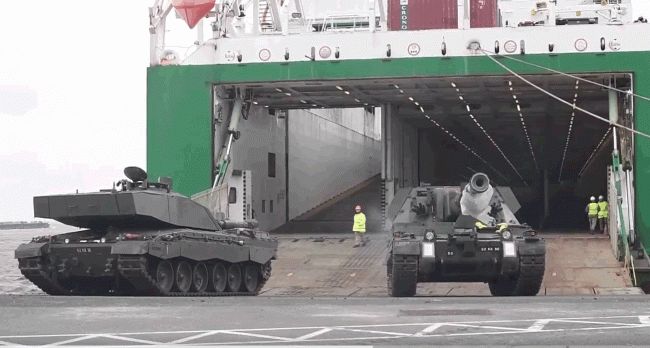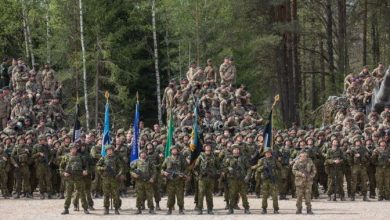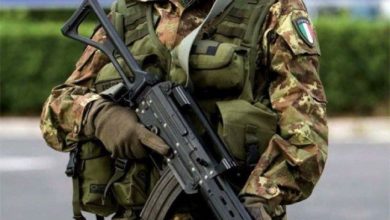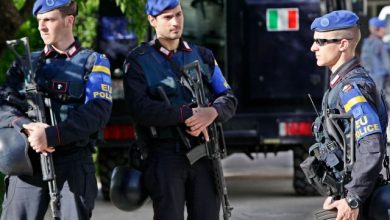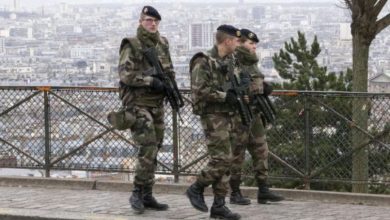NATO moving tanks and troops to the Russian border
NATO has started to move a whole army of military hardware and personnel to the Baltics. Over the last days, Estonia’s Permanent Representation to NATO has reported a number of big operations on Twitter. On Sunday, it posted a video picturing 300 tanks, armored vehicles and self-propelled guns moved from Great Britain to Estonia.
NATO has started to move a whole army of military hardware and personnel to the Baltics. Over the last days, Estonia’s Permanent Representation to NATO has reported a number of big operations on Twitter. On Sunday, it posted a video picturing 300 tanks, armored vehicles and self-propelled guns moved from Great Britain to Estonia.
Estonia’s Permanent Representation to NATO reported the transfer of French military hardware to Estonia and posted a video picturing a train transporting dozens of armored vehicles, trucks and even ambulance cars. “#French vehicles passing via #Sokółka, #Poland on their way to #Estonia. Equipment is a part of #eFP #battlegroup,” says the author of the video Cezary Stachniak, logistician on NATO’s Eastern Flank / Poland & Baltic States defense issues.
Moreover, yesterday the Baltic office of the North Atlantic Alliance also announced the transfer of French military equipment to Estonia. The video shows how the train transports dozens of armored cars, armored personnel carriers, trucks, tractors and even ambulances.
“French technology passes through the Sokolka station in Poland on the way to Estonia. The equipment is part of NATO’s expanded advanced forces (in the Baltic states), ”wrote Cesari Stachniak, whose video was shared by the NATO mission in Estonia. This user represents himself on Twitter as a logistics provider on the eastern flank of the Alliance.
French armored vehicles pass Poland on their way to Estonia
According to NATO Spokesperson Oana Lungescu, around 120 soldiers from Britain’s 5th Battalion The Rifles Battlegroup arrived in Estonia as part of an effort to boost NATO’s presence in the region. Postimees specifies that NATO’s force is deployed in Tapa, just 150 km far from the Russian border. By Apr 2017, the force is supposed to comprise 1,200 British and French soldiers.
According to Forces.net, there already are 200 U.S. soldiers with Bradley vehicles and Abrams tanks in Estonia.

Since 2015 the Americans have been conducting an operation to enlarge their presence in Europe and they already have troops in the Baltics. Their biggest force is located in Latvia. According to the Czech Offiziere website, they have almost 500 vehicles and 400 soldiers there.
Besides Estonia, NATO is dispatching troops to Lithuania. NATO’s office in Lithuania has reported the arrival of Dutch military equipment to the Lithuanian port of Klaipeda. The photos and the video picture tans and self-propelled guns.
The source says that NATO’s decision to deploy four multinational battalions to Estonia, Latvia, Lithuania and Poland was announced by NATO Secretary General Jens Stoltenberg after the July 2016 summit in Warsaw. This is NATO’s biggest operation in several decades. Each of the states will have a NATO battalion. According to NATO, this is not a threat to Russia but a way to show that an attack on any of the NATO members will be regarded as an attack on the whole alliance.
Russian Izvestia newspaper quotes Russia’s Foreign Minister Sergey Lavrov as saying that NATO’s actions in the Baltics are provocative and destabilizing. “This policy implies no practical contacts with us, growing distrust and imbalance in Europe. We are acting likewise so as to neutralize potential and real threats. We are an amicable country but our amicability is based on our ability to ensure our security in any situation,” Lavrov said.
In 2016, Russia’s response to NATO’s growing presence in Europe was the dispatch of Iskander-M ballistic missile system to Kaliningrad region. In Mar 2017, German foreign ministry said that that might nullify the efforts to ensure security in Europe. The Russian President’s Spokesman Dmitry Peskov said that Russia was not going to take Iskanders away from Kaliningrad. “We can’t just remove them until we know that the plans to create a whole anti-Russian missile system in Europe are cancelled,” he said.
This post is also available in:
 English
English  Русский (Russian)
Русский (Russian)

